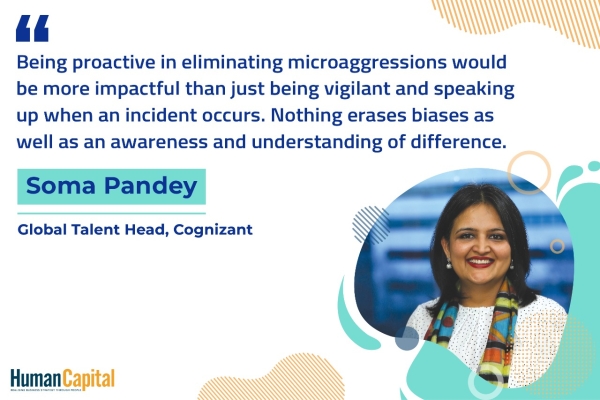The COVID-19 pandemic has disrupted the dynamics of work, workforce, and workplace forcing organisations to revisit their strategies to align with revised business goals. However, due to an imbalance in supply and demand for all resources, most employers have adopted a cost optimisation approach for business continuity. The partial weight of cost optimisation came in the form of layoffs, salary cuts, hiring freeze, deferred incentive pay-outs, promotions without a hike, or no salaries, eventually disturbing the compensation structure of fixed remunerations, incentives, and benefits pay-outs.
Human capital is the key resource and thus, it becomes challenging to strike a balance between motivating the workforce to be productive remotely and saving cash at the same time. With employee safety and well-being being the priority, the new normal of remote working is expected to stay for a while. Recently, an Amazon spokeswoman informed its employees in an email statement that “Employees who work in a role that can effectively be done from home are welcome to do so until June 30, 2021”. Similarly, companies like Facebook, Google, Microsoft, Twitter, etc. have a similar proposition on the extension of work-from-home duration.
Consequently, performance and rewards metrics for employees working remotely will have to be thoughtfully designed keeping the need of employees and business requirements in mind.
Evaluating Employee Performance
Evaluating the performance of employees working remotely will require consideration of the COVID-19 effect. It may have to be more empathetic as each employee is dealing with different circumstances at a personal and professional level.
Following are some of the evaluations criteria adopted or that may be adopted in the new normal:
Clear Goal Setting: Most performance experts suggest that the time has come for frequent evaluation —shifting long-term goals to short-term goals by breaking them down to a weekly, monthly, or quarterly basis.
Communication of the Objectives and KRA to employees with clear direction is mandatory to avoid any discrepancies later. The focus should be on output than the process as the productive hours of each employee might differ due to the physical setup.
Upskilling & Innovation: Employees have an opportunity to make themselves more employable by learning new skills and providing finesse to their existing skills leading to better performance. Metrics of performance may be:
♦ Did the employee take advantage of learning platforms provided by the organisation? What kind of innovative and unique solutions did the person find for problems?
♦ Did the employee show a sign of flexibility and adaptability to adjust to new norms?
Leadership: One may evaluate how managers pulled the team together in this hour of crisis and met project goals with empathy for the team. They can be rewarded for the mentoring and coaching they provided to improve the performance of their teams by constantly giving feedback or reviews. It would stand organisations in good stead to reward frequent, open, and transparent communication that drives trust and empowers teams to take ownership and accountability resulting in a self-motivated workforce. Hard conversations on performance improvement, if any, should be encouraged and acknowledged too.
Reward Strategies for New Normal
Communication of business and individual/team goals with proper mentoring is a key to keep employees engaged and motivated to perform. The focus of employers should be a reward strategy with a holistic view of how the three components of compensation – fixed, variable, and benefits & perks can be restructured to cater to the new normal. Interventions like dipstick surveys or informal discussions to understand the needs of employees may help to frame the new reward strategy.
Variable Pay: Rewarding employees fairly with what is necessary for survival in the current scenario is the priority. In these turbulent times, employees may be temporarily fine with deferred variable pay-out, delayed merit hike, deferred/suspended promotions, or no incentive pay-out than getting furloughed or laid off. At the senior and mid-level, some organisations may consider converting a portion of fixed compensation to variable pay and linking it to employee performance and productivity.
Such measures may help to save cash for now and act as a retention lever. It will also push employees for ownership and accountability of KRAs assigned. Promotions with pay hikes later can also be one of the ways to retain top talent. It’s effective and a win-win situation for both parties.
According to KPMG in India’s COVID-19 HR practices survey report, 2020 titled “Cutting through the crisis” which had responses from 319 organisations across 20 industry sectors, “Almost 50 per cent of the respondents have reported that their organisations have deferred/ suspended promotion cycle, except for junior management. More than 50 per cent of the responding organisations have reported either a deferral or freezing/suspension of the planned increment cycle across levels”.
Learning Opportunities as Reward: This is a time when employers have learning & development on top of the list to upskill, reskill, or cross skill their employees to make them relevant in the future ahead. Rewarding employees with relevant and engaging digital learning/course content supported by effective learning tools/technology can create a good employee experience. Employees are also keen on self/ career development to make them more employable. Upskilling and innovation achieved through availing this opportunity can be criteria for performance evaluation too.
Health Care Plans: The medical insurance plan benefit in terms of coverage, terms, and conditions may be reworked to include hospitalisation costs for COVID, quarantine, and diagnostics costs, if any, along with seamless support for execution of the same through TPAs or internal teams.
Employee Well-being: Organisations must think of sessions related to Yoga, Covid awareness, lifestyle management, ergonomics, music, family or kids’ entertainment, online medical counselling, etc. Psychological support should be encouraged in the form of teleconsultation for employees who are on the verge of burnout due to stress.
Additional Benefits to support WFH: To create an office like set up at home, employees should be facilitated with the required infrastructure. Organisations are supporting one-time purchase or reimbursements for ergonomic chairs, laptop/desktop tables, broadband connections, headphones, and keyboards among others.
Informal way to reward: At times, non-financial rewards like personal recognition, name on leadership boards, a thank you note/appreciation e-mail for a specific task, time offs, virtual paid lunches, flexible working hours, or customised leave can boost up the morale of employees to deliver in the current situation.
Reward strategy should be reset in a way that benefits the end-user, employees in this case, and is aligned with business priorities. To have a win-win situation, a balance between the interests of both parties is the key to survive in the turbulent time of this pandemic.
Is your organisation post-COVID-ready?
Trending
-
SBI General Insurance Launches Digital Health Campaign
-
CredR Rolls Out 'Life Happens' Leave For Its Employees
-
Meesho Announces 30-Week Gender-Neutral Parental Leave Policy
-
Microsoft Unveils Tech Resilience Curriculum To Foster An Inclusive Future
-
60% Indian Professionals Looking For Job Change Due To COVID: Survey
-
SpringPeople And Siemens Collaborate For Digital Transformation Push
-
86% Professionals Believe Hybrid Work Is Essential For Work Life Balance: Report
-
Almost 1 In Every 3 People's Personal Life Affected Due To Work Stress
-
Meesho Rolls Out Reset And Recharge Policy For Employees
-
80% Of Talent Leaders & Academics Say Pandemic Changed Skill Needs For Youth: Report
-
Hero Electric Rolls Out 'Hero Care' Program For Employees
-
Human Capital In Collaboration With ASSOCHAM Hosts Virtual Conference
-
IKEA India, Tata STRIVE Collaborate To Create Employability And Entrepreneurship Opportunities
-
SAP India, Microsoft Launch Tech Skilling Program for Young Women
-
DXC Technology, NASSCOM Collaborate For Employability Skills Program
-
Lenskart To Hire Over 2000 Employees Across India By 2022
-
Mindtree Launches Learn-and-Earn Program
-
Tata AIA Extends 'Raksha Ka Teeka' To Its Employees
-
Swadesh Behera Is The New CPO Of Titan
-
NetConnect Global Plans To Recruit 5000 Tech Professionals In India
-
Hubhopper Plans To Hire 60% Of Indian Podcasters By 2022
-
Corporate India Needs More Women In Leadership Roles: Report
-
Aon to Invest $30 Million and Create 10,000 Apprenticeships by 2030
-
Tech Mahindra Launches ‘Gift a Career’ Initiative for Upskilling of Youth
-
40% Women Prefer Flexible Working Options in Post-COVID World: Survey
-
3 out of 4 companies believe they can effectively hire employees virtually: Report
-
Vodafone , CGI and NASSCOM Foundation launch digital skills platform
-
Odisha: Bank, postal employees to deliver cash for elderly, differently-abled persons
-
Skill India launches AI-based digital platform for "Skilled Workforce"
-
Hiring activity declines 6.73% in first quarter: Survey
-
70% startups impacted by COVID-19 pandemic
-
Bajaj Allianz Life ropes in Santanu Banerjee as CHRO
-
Over 70 Percent MSMEs look at cutting jobs to sustain businesses
-
93 Per Cent employees stressed about returning to office post-lockdown
-
Johnson & Johnson India announces family benefits for same gender partners
-
Indian firms turning friendly towards working mothers
-
Welspun India names Rajendra Mehta as new CHRO
-
Wipro partners with NASSCOM to launch Future Skills platform



Human Capital is niche media organisation for HR and Corporate. Our aim is to create an outstanding user experience for all our clients, readers, employers and employees through inspiring, industry-leading content pieces in the form of case studies, analysis, expert reports, authored articles and blogs. We cover topics such as talent acquisition, learning and development, diversity and inclusion, leadership, compensation, recruitment and many more.
Subscribe Now



.JPG)










































Comment